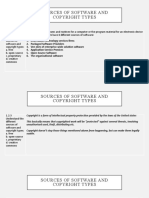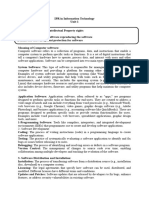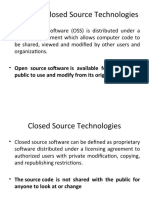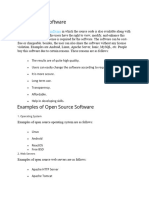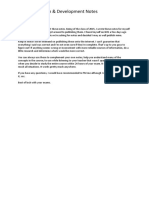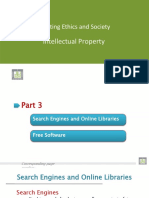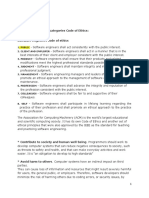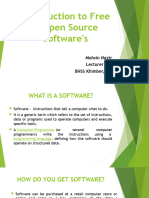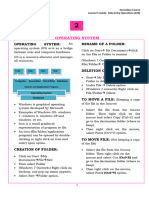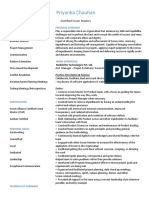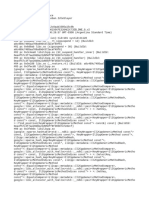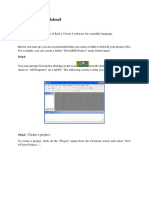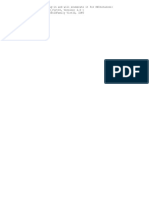Handouts of Lecture 16 Professional Practices (IT)
Lecture Title: Intellectual Property Rights (Cont.)
Protections for Software
Software Copyright?
• A copyright protects how a software program is written — its code and screen designs.
• It does not protect the idea behind the software.
Example: You can copyright your code for a calculator app, but not the idea of a
calculator.
• A copyright usually covers:
o The object code (the file the computer runs)
o The screen display (what the user sees)
o But not usually the source code (it’s often a company secret)
What counts as Software Copyright Violation?
Doing these things without permission is illegal:
1. Copying software to sell or share with others
2. Installing software on a computer before selling it
3. Sharing software over the internet
Even when you install or run a program, you're technically copying it, but your software license
usually allows that.
Key Court Cases
Apple v. Franklin
• Franklin copied Apple's code into its own computer.
• Court ruled: You cannot copy code from another company, even if it's the object
(executable) version.
Page 1 of 5
� Sega v. Accolade
• Accolade wanted to make games for the Sega console.
• Since Sega didn’t share how their console worked, Accolade reverse-engineered the
code to learn.
• Court ruled in favor of Accolade: it was fair use because they didn’t copy the code
— they just learned how it worked.
What is “Clean Room” Software Development?
This is a safe way to build software similar to another product without copying:
1. Team A studies the competitor’s software and writes down what it does.
2. Team B (who never saw the original software) builds new code using just Team A’s
notes.
This protects against copyright violation because nothing was copied directly.
What is a Software Patent?
• A patent protects a new idea or method in software — not how it's written, but how it
works.
• Example: If you invent a new way to compress images, you can patent that method.
• Companies:
o Make money from patents by licensing them.
o Fight legal battles to protect or attack over patent rights.
Example: NTP v. BlackBerry (RIM)
• NTP owned patents for wireless email.
• They sued BlackBerry for using that idea without permission.
• BlackBerry had to pay $612.5 million to settle the lawsuit.
Problems with Software Patents
Page 2 of 5
� • Too many software patents are granted — even for obvious ideas.
• Patent examiners often miss “old code” because it’s not in patent records.
• Some companies called “patent trolls” buy patents just to sue others for money.
• Lawsuits are expensive, so companies often settle instead of fighting.
Solution Ideas
• Some say software patents should only last 3 to 5 years (like Jeff Bezos suggested)
instead of 20 years.
• Others think software shouldn’t be patented at all.
Key Differences: Copyright vs Patent
Feature Software Copyright Software Patent
The way code is written The method or idea behind the
What it protects
(expression) software
Covers Object code, screen design Invention, method, system
Length of
Life of the author + 70 years Usually 20 years
protection
Example Game graphics, program UI New algorithm, drag-and-drop idea
Stops others from using your
Use case Stops others from copying code
invention
Open-Source Software?
Open-source software is software that anyone can:
Use
View (the source code)
Change
Share with others — for free or even sell it
Example:
• Linux, Firefox, and VLC Media Player are all open-source.
Page 3 of 5
� What is Proprietary Software?
This is the opposite of open-source.
• Companies keep the source code secret (like a recipe).
• You can’t change it or share it.
• When you "buy" it, you’re actually buying a license to use it — not to own or copy it.
Example:
• Microsoft Windows, Adobe Photoshop, and MS Office are proprietary.
Why Open Source Started?
In the past, copying was hard. Now with computers, it’s super easy to copy and share software.
Some people (like Richard Stallman) believed it’s unfair to stop people from sharing.
He argued:
• Copyright should promote progress, not control people.
• It’s wrong to stop someone from helping a friend by giving them a copy.
• Software should be about cooperation, not control.
This led to the open-source movement, where people build software together, share it freely,
and improve it as a team.
What Makes Software Truly “Open Source”?
To be open source, the license (rules) must allow:
1. Free sharing — you can sell or give it to anyone.
2. Access to source code — must be included or downloadable.
3. Freedom to modify — you can improve or change it.
4. Freedom to use — in any way you like.
5. Equal rights for everyone — no special permissions needed.
6. No control over other programs — can mix with non-open software.
Page 4 of 5
� 5 Benefits of Open-Source Software
1. Anyone Can Improve It
• Fix bugs
• Add new features
• Adapt it for new uses
Example: Someone might take open-source software and build a new app from it.
2. Faster Updates
• Open-source programs get bug fixes and updates more quickly than commercial ones.
No need to wait months for updates like with big companies.
3. No Guilt Sharing
• You don’t break any law if you give a copy to your friend.
It’s legal and encouraged!
4. Belongs to the Community
• Not owned by one company.
• If a company stops updating, the community can continue development.
It keeps software alive even if the original creators stop.
5. Focus on Service, Not Selling
• Since the code is free, companies make money by offering help/support.
Better service means happier users!
Page 5 of 5







